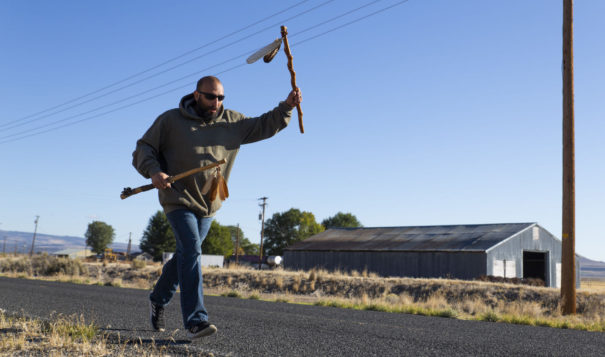News Based on facts, either observed and verified directly by the reporter, or reported and verified from knowledgeable sources.
MODOC ANCESTRAL RUN RETURNS TO HEART OF TRIBES’ CREATION STORY
 James Ramos runs with the staff held high during the annual Modoc Ancestral Run on Oct. 9
James Ramos runs with the staff held high during the annual Modoc Ancestral Run on Oct. 9
For likely the first time in more than 150 years, Modoc people slept atop The Peninsula on Friday night.
The Peninsula — a distinct, rocky peak near Newell and adjacent to Petroglyph Point — means much to a people who were largely torn from their homeland by various federal policies and a vicious war.
“The Peninsula is the first piece of land that our Creator made when he was making the world of the Modoc people,” said Monica Yellowowl, run leader for the annual Modoc Ancestral Run.
The run is a grassroots effort to “put our feet on the ground where our people haven’t been since contact, since the Indian Wars and forced relocation,” she said.
Last year’s run route, a 136-mile effort that went from Fort Klamath to Lava Beds, took participants through Klamath Falls for the first time. The first night of this year’s two-day, 85-mile relay run ended atop the Peninsula.
“It was really windy at first and really cold, but as soon as we all tucked away into our sleeping bags, it just became very still and the only thing you could hear was the blood rushing in your ears and I found it to be very peaceful,” said Stacy Parrish, a Klamath Tribes member living in Denver. Parrish has joined runs like this for the past four years. “Our stories say that that’s a place of power and there was something about that place that just made me feel like it was OK to rest and just not think about anything but that moment … I’ve gotten the best sleep that I’ve gotten in so long up there.”
Day two — Saturday — began with sunrise and ceremony. From there, they runners made their way to Fern Cave, another place of power, where “only the most powerful of medicine people would go,” Parrish said. After the cave they ran to the Stronghold, where a Captain Jack-led band of Modoc warriors held out for much of the 1872-73 Modoc War. After the run, a feast.
The run is relay style, Yellowowl said. Those running at any given moment carry the run staff, passing it on to the next person stationed along the route.
The run staff is rife with symbolism, as its composed of a Juniper branch with four feathers from a red-tailed hawk, an eagle feather and deer “toes” attached to it. They represent endurance, while the eagle feather is for an elder who passed before the runs began, and the hawk feathers represent the four Modoc leaders hung by the U.S. after the war.
“When you have the staffs in your hands and when you hear the deer toes making a very rhythmic noise and you’re just running, it’s hard to run but it’s so powerful to run,” Parrish said. “It’s really hard to describe. You’re running for something far bigger than yourself and things you can’t even see. That’s why you run.”
Yellowowl said they also sing a song pulled right from words uttered in the Stronghold during the war: Kai kai nu shuaina uli kiu kaila kelli widshash.
“Sentiment meaning: ‘No no I don’t want to leave my homeland/place that I come from,’” Yellowowl said.
This year’s run honored Charlene Jackson, a Modoc elder who Yellowowl described as “our run matriarch.” Jackson, 77, died in May.
“From waking up to greeting the sun, to our run prayers, to putting our feet on the ground and going into places and bases and nooks and crannies of our homeland. All of that is Charlene. Every single piece of it is Charlene,” Yellowowl said.
Jackson ran every year, even after an open heart surgery.
“She’d come out and pray for people, pray for Monica, pray for all of us,” said Gilbert Jackson, Charlene’s son. “It was a big honor for that. The emotions carry over because you’re still remembering these things, you know? And that’s good because our little ones are here and we’re including them to teach them.”
Kailynce Crume was among four generations of his family present on the run this weekend. Crume, currently a sophomore at Henley, has participated in the run for the last seven years. A bad knee injury limited Crume this year, but it couldn’t hold him out.
“We pretty much exclude everything out of our lives to make sure he has events like this,” said Kailynce’s mother, Lupe. “Like he said, it’s healing… Although physically he’s not 100 percent, mentally and spiritually he’s 100 percent in this moment.”
Parrish said being able to come back for the run and ceremony is important for her to stay connected, but to also teach her son, Blue.
“Ceremony is very sacred for us, and it’s what keeps us alive,” Parrish said.
